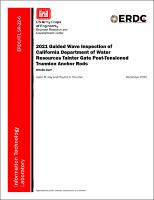Please use this identifier to cite or link to this item:
https://hdl.handle.net/11681/46282Full metadata record
| DC Field | Value | Language |
|---|---|---|
| dc.contributor.author | Ray, Jason D. | en_US |
| dc.contributor.author | Thurmer, Clayton R. | en_US |
| dc.creator | Information Technology Laboratory (U.S.) | en_US |
| dc.date.accessioned | 2022-12-22T20:09:35Z | en_US |
| dc.date.available | 2022-12-22T20:09:35Z | en_US |
| dc.date.issued | 2022-12 | en_US |
| dc.identifier.govdoc | ERDC/ITL SR-22-6 | en_US |
| dc.identifier.uri | https://hdl.handle.net/11681/46282 | en_US |
| dc.identifier.uri | http://dx.doi.org/10.21079/11681/46282 | en_US |
| dc.description | Special Report | en_US |
| dc.description.abstract | The Engineering and Test Branch within the Division of Operations and Maintenance of the California Department of Water Resources (DWR) and U.S. Army Corps of Engineers (USACE), Sacramento District, tasked the Sensor Integration Branch (SIB) at the Engineer Research and Development Center (ERDC) to perform nondestructive testing (NDT) on the trunnion anchor rods at Oroville Dam through the use of ultrasonic guided waves. This is the fourth year of this NDT. The results of the testing are presented along with qualitative analysis in determining whether a rod is intact or compromised. Analysis is based upon the expected results from other rods at the site, knowledge of rod response at other sites, data gathered from the trunnion rod research test bed at ERDC, and comparison to the previous year’s effort. | en_US |
| dc.description.sponsorship | Prepared for U.S. Army Corps of Engineers, Sacramento District under MIPR W62N6M13089302 | en_US |
| dc.description.tableofcontents | Abstract .......................................................................................................................................................... ii Figures ............................................................................................................................................................ iv Preface ............................................................................................................................................................. v 1 Introduction ............................................................................................................................................ 1 1.1 Background ..................................................................................................................... 1 1.2 Objectives ........................................................................................................................ 1 1.3 Approach ......................................................................................................................... 1 1.4 Scope ............................................................................................................................... 2 1.5 The guided wave test system ......................................................................................... 2 2 Pretest ..................................................................................................................................................... 4 3 Results .................................................................................................................................................... 5 3.1 Condition ......................................................................................................................... 5 3.2 2021 results compared to 2020 ................................................................................... 5 3.2.1 Results labeled as Variance from Previous Year ............................................................. 15 3.2.2 Results labeled as No Issue .............................................................................................. 17 3.2.3 Results labeled as Anomaly .............................................................................................. 17 3.2.4 Results labeled as Possible Defect .................................................................................. 17 3.2.5 Rods 4-2 and 4-14 ............................................................................................................ 17 4 Conclusion and Recommendations ................................................................................................ 27 Reference ..................................................................................................................................................... 28 Acronyms and Abbreviations .................................................................................................................... 29 Report Documentation Page | en_US |
| dc.format.extent | 38 pages / 2.99 MB | en_US |
| dc.format.medium | en_US | |
| dc.language.iso | en_US | en_US |
| dc.publisher | Engineer Research and Development Center (U.S.) | en_US |
| dc.relation.ispartofseries | Technical Report (Engineer Research and Development Center (U.S.)) ; no. ERDC/ITL SR-22-6 | en_US |
| dc.rights | Approved for Public Release; Distribution is Unlimited | en_US |
| dc.source | This Digital Resource was created in Microsoft Word and Adobe Acrobat | en_US |
| dc.subject | Hydraulic structures | en_US |
| dc.subject | Hydraulic gates--Testing | en_US |
| dc.subject | Ultrasonic waves--Testing | en_US |
| dc.subject | Oroville Dam (Calif.) | en_US |
| dc.title | 2021 Guided Wave Inspection of California Department of Water Resources Tainter Gate Post-Tensioned Trunnion Anchor Rods : Oroville Dam | en_US |
| dc.type | Report | - |
| Appears in Collections: | Special Report | |
Files in This Item:
| File | Description | Size | Format | |
|---|---|---|---|---|
| ERDC-ITL SR-22-6.pdf | ERDC/ITL SR-22-6 | 2.99 MB | Adobe PDF |  View/Open |